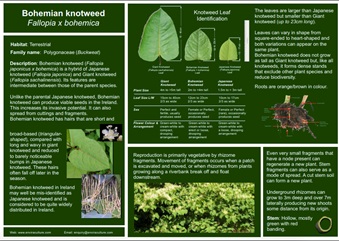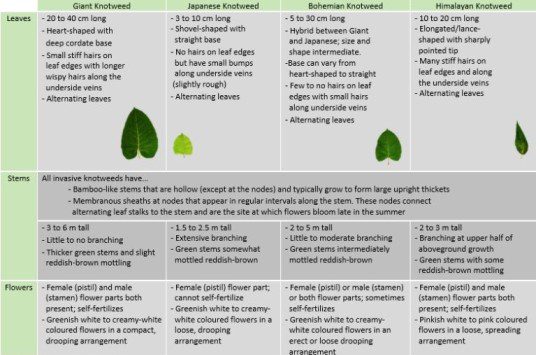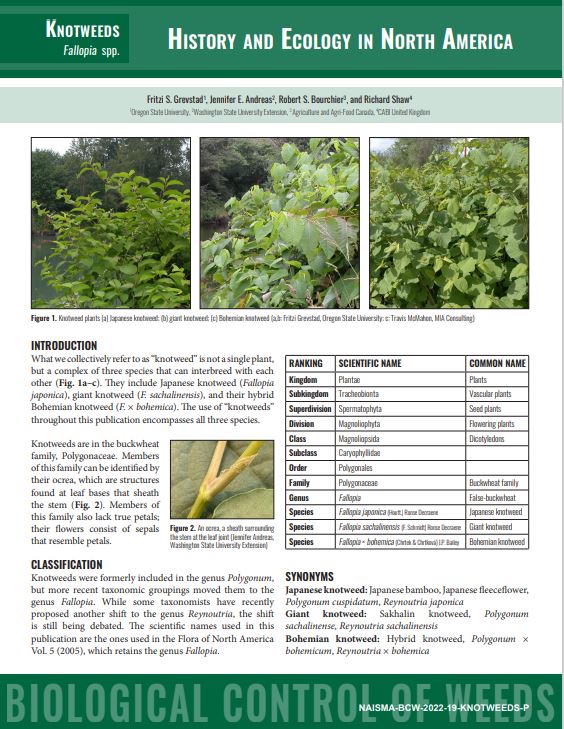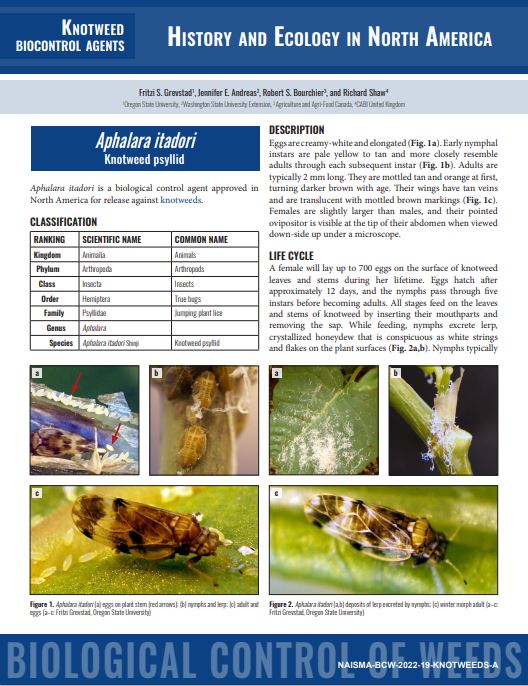Bohemian Knotweed (Reynoutria x behmica)

Photo: Robert Vidéki, Doronicum Kft., Bugwood.org

Photo: Robert Vidéki, Doronicum Kft., Bugwood.org
Order: Polygonales
Family: Polygonaceae
French common name: Renouée bohème
Additional names commonly used: Fallopia x bohemica, Polygonum x bohemicum
Did you know? Bohemian knotweed is a hybrid offspring of Japanese and Giant knotweed but is more aggressive (and therefore more invasive) than either species. Bohemian knotweed can closely resemble its parents and is most commonly misidentified as Japanese knotweed.
Introduction
Bohemian knotweed is an invasive herbaceous plant that threatens ecosystems and native plants in Canada. While it is possible that Bohemian knotweed was introduced directly from Asia, it is more likely that it became established in North America, from crosses between Japanese and Giant knotweed that were already here.
Bohemian knotweed was underreported for a long time because of misidentification, and as a result it was believed to be a less problematic invader. It is now known that Bohemian knotweed is actually quite abundant and is able to occupy habitats that neither parent species can.
Removal of this invasive knotweed can be difficult because of its seed dispersal and vegetative reproduction from rhizomes and roots. Rhizomes increase the size of individual plants by creating extensive networks and allow for the growth of entirely new plants in different areas if disturbed.
Learning how to prevent and manage Bohemian knotweed is incredibly important to avoid potential ecological, economic, and social harm.
General Information
*The best way to distinguish Bohemian knotweed from other invasive knotweed is by comparing the leaf shape and leaf hairs


Leaves: The size and shape of Bohemian knotweed leaves can vary. Bohemian knotweed leaves are 10 to 20 cm (about 4 to 8 in) long, which is about the width of a standard sheet of paper. They can be shovel-shaped with a flat base like Japanese knotweed or have a heart shaped base that tapers off to the tip like Giant knotweed (although shape is more subtle/not as pronounced compared to Giant knotweed). A variety of these leaf shapes are usually found on the same plant and are a good identifier for Bohemian knotweed. The edges of their leaves tend to feel smooth but tiny hairs can be found on the leaf underside along the veins.
Flowers: Bohemian knotweed have small greenish white to creamy-white flowers that are in an erect or loose drooping arrangement and occasionally produce seeds. They can have both male and female flower parts to self-fertilize but have also been found with only female or male flower parts. Flowers bloom mid-August to late-September and can continue for several weeks or until the presence of frost.
Size: Bohemian knotweed can grow to be 2 m to 5 m (about 6.5 to 16.5 ft) tall.
Stem: They have bamboo-like stems that branch and are hollow everywhere except the nodes. Their green stems are mottled reddish brown, with this darker colour appearing more heavily at the nodes. The nodes have membranous sheaths and are spaced regularly along the stem.
Roots: Like all invasive knotweed, Bohemian knotweed rely primarily on vegetative reproduction with rhizomes to grow and spread. These rhizomes are underground and grow several meters past the plant to send out new shoots and roots. When cut, rhizomes appear orange in colour.
Bohemian knotweed are perennial plants, meaning they survive longer than two years and have annual cycles where they germinate (grow new roots and shoots), flower, produce seed, then become dormant all in one year before starting over again.
New shoots emerge from the ground in warmer temperatures from mid-spring to late summer. These thin, pointy shoots grow very quickly, and have been shown to gain 5 – 10 cm (2 – 4 in) in height within a single day. New shoots and roots grow by vegetative reproduction using underground rhizomes.
Rhizomes are horizontal modified stems that extend several metres beyond the plant to expand its range and grow bigger. These rhizomes are the primary source of new growth for Bohemian knotweed and can generate an entirely new plant when broken off. If a plant is disturbed and a broken off segment of rhizome is transported (by human activity or water) to new soil, it can start to grow new roots and shoots. Bohemian knotweed is thought to have rhizomes that regenerate more quickly and therefore spread more rapidly than either parent.
Flowers start to bloom from mid-August to late September and sometimes produces fertile seeds. Bohemian knotweed flowers can be female, male, or perfect (both female and male parts).

The pollen produced by Bohemian knotweed can be used to fertilize and cross with Japanese knotweed. Bohemian knotweed can also be pollinated by nearby Giant knotweed to produce seeds. Seeds will grow and become visible a few weeks after flowering.
When temperatures begin to drop and frost appears, the aboveground growth of Bohemian knotweed dies, and the plant becomes dormant for the winter. During this time, the aboveground stalks appear brown and dead.

Bohemian knotweed is thought to be more aggressive and tolerant to a wider range of habitats compared to its Japanese and Giant knotweed parent species. Like all invasive knotweed, Bohemian knotweed is thought to tolerate a variety of soil, nutrient, pH, moisture, and sunlight conditions but prefer brightly lit areas that are higher in moisture content.
They seem to thrive in riparian zones (such as beaches, shorelines, canals, and wetlands) and areas where soils have been disturbed (such as roadsides, ditches, and lawns). It can also grow in semi-shaded environments but is less likely to establish in drier places with less access to sunlight, such as forests with dense canopy cover.
It is unclear whether Bohemian knotweed was introduced from Asia directly or if it emerged in Canada as a cross between Giant and Japanese knotweed that were already established. For many years they were misreported as one of their parent species.
Since its recognition as a hybrid species, Bohemian knotweed has been identified in British Columbia, Ontario, and Quebec. Some sources also report its presence in New Brunswick, Prince Edward Island, Nova Scotia, and Newfoundland and Labrador, which is likely correct as it overlaps with parent species habitat and is still often confused with Japanese knotweed.
To report a sighting or to check up-to-date distribution maps of recent reports, visit EDDMapS.
The ecological, economic, and social impacts of Bohemian knotweed are often considered together with Japanese knotweed, but it is generally assumed all knotweed pose similar threats. Bohemian knotweed may have the greatest impacts as it is more aggressive and widespread in North America. It is difficult to find specific studies outlining the impacts in Canada or the United States, but studies focusing on infestations in European countries can provide some insight.
Ecological Impacts:
Bohemian knotweed has been shown to grow and regenerate more quickly than its parent species. It also releases more underground allelopathic substances (harmful chemicals) that inhibit growth of nearby native plants. As a result, fast growing Bohemian knotweed can out-compete native plants by restricting their access to sunlight, water, and nutrients.
Bohemian knotweed reduces biodiversity by displacing native species and negatively affecting the wildlife that rely on native vegetation. It prefers to grow along bodies of water and can destabilize riverbanks, potentially damaging waterways and water quality.
Some studies have shown that Bohemian knotweed populations can potentially have more genetic variation, meaning this species will likely respond well to environmental changes (e.g., climate change).
Economic and Social Impacts:
Bohemian knotweed is a habitat generalist, meaning it can invade new habitats quickly. Removing or managing its expansive growth can be quite costly (e.g., through chemical control or labour fees). Bohemian knotweed that grows through cracks in concrete, foundation, asphalt, or other forms of infrastructure can also be expensive to repair for both municipalities and homeowners. Its presence in yards can make homes look neglected and can even reduce property values.
Management
Most research on effective management has focused on Japanese knotweed but it is assumed by most that these strategies will work across all species of invasive knotweed.
- Prevention is key: learn how to properly identify and report any sightings of Bohemian knotweed. Bohemian knotweed is considered the most difficult knotweed to control and manage, so preventing its establishment in new areas can be incredibly useful to stop its spread. It is possible to eradicate in new areas if caught early enough before rhizomes have the opportunity to spread.
- Do not buy or plant Bohemian knotweed.
- Mechanical control (e.g., mowing and cutting) is thought to be ineffective unless followed by chemical applications. While mowing and cutting can create short-term dieback, it can lead to long-term regrowth if done incorrectly (e.g., if cuttings aren’t bagged to dry out or if loose pieces of plant spread to colonize new areas). If mechanical controls are used, they should be performed repeatedly when new growth appears to continually deplete stored energy in the rhizomes. For best results, herbicides should be applied immediately after cutting. Foliar sprays or stem injections also need to be applied repeatedly throughout the season.
- Hand-pulling should be avoided because rhizomes spread metres underground and can sprout new plants when disturbed.




